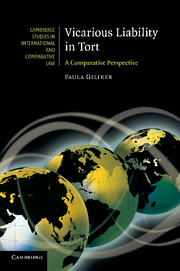Book contents
- Frontmatter
- Contents
- Diagrams
- Table of cases
- Table of legislation
- Preface
- 1 What is vicarious liability?
- 2 Establishing a general framework for liability
- 3 The employer/employee relationship: identifying the contract of employment
- 4 Special difficulties: borrowed employees and temporary workers
- 5 Other relationships giving rise to liability
- 6 Acting in the course of one's employment/functions/assigned tasks: determining the scope of vicarious liability
- 7 Parental liability for the torts of their children: a new form of vicarious liability?
- 8 Understanding vicarious liability: reconciling policy and principle
- 9 A postscript: a harmonised European law of vicarious liability?
- Appendix: Key provisions of the French and German Civil Codes
- Index
- Titles in the series
Preface
Published online by Cambridge University Press: 10 November 2010
- Frontmatter
- Contents
- Diagrams
- Table of cases
- Table of legislation
- Preface
- 1 What is vicarious liability?
- 2 Establishing a general framework for liability
- 3 The employer/employee relationship: identifying the contract of employment
- 4 Special difficulties: borrowed employees and temporary workers
- 5 Other relationships giving rise to liability
- 6 Acting in the course of one's employment/functions/assigned tasks: determining the scope of vicarious liability
- 7 Parental liability for the torts of their children: a new form of vicarious liability?
- 8 Understanding vicarious liability: reconciling policy and principle
- 9 A postscript: a harmonised European law of vicarious liability?
- Appendix: Key provisions of the French and German Civil Codes
- Index
- Titles in the series
Summary
Like most lawyers, I first came across the doctrine of vicarious liability in tort as a student. I found it somewhat of an oddity: a principle of strict liability in an area of law dominated by fault, notably the tort of negligence. Vicarious liability seemed to be the cuckoo in the nest; imposing liability without fault on innocent parties (usually employers) regardless of their attempts to exercise reasonable care. I soon learnt that whilst the doctrine was regarded as an indispensable element of the law of torts, my textbooks could provide no clear rationale for its existence and that, in practice, uncertainty seemed to arise at each stage of its operation: was there a relationship giving rise to vicarious liability? What connection had to exist between the employee's (it is in most cases the employee) misconduct and the job he was supposed to perform? Frustratingly, later, as a teacher and lecturer in law, these problems continued to trouble me and, dare I say, intensified in the face of cases arising from the Supreme Courts of leading common law jurisdictions in 1999, 2001 and 2003 in which the most learned judges of each jurisdiction struggled both to provide an explanation for vicarious liability and a legal framework in which the doctrine could be applied. Further, as a comparative lawyer, I came to realise that this was not just a common law problem.
- Type
- Chapter
- Information
- Vicarious Liability in TortA Comparative Perspective, pp. xli - xlivPublisher: Cambridge University PressPrint publication year: 2010
- 1
- Cited by



